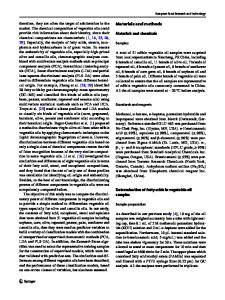Characterization of a Natural Dye by Spectroscopic and Chromatographic Techniques
- PDF / 360,014 Bytes
- 11 Pages / 432 x 648 pts Page_size
- 0 Downloads / 342 Views
Characterization of a Natural Dye by Spectroscopic and Chromatographic Techniques Y. Espinosa-Morales1, J. Reyes1, B. Hermosín2, J. A. Azamar-Barrios3 Centro de Investigación en Corrosión, Universidad Autónoma de Campeche. Avda. Agustín Melgar s/n entre Juan de la Barrera y Calle 20. Colonia Lindavista, San Francisco de Campeche, México. e-mail: [email protected] 2. Instituto de Recursos Naturales y Agrobiología de Sevilla (IRNAS-CSIC), Spain. 3 CINVESTAV-Unidad Mérida, México. 1
ABSTRACT Natural dyes have been extracted from both plants and animal to give color to textiles and handicrafts. This is the case of purple dye extracted from Justicia spicigera Schldt, an acanthaceae used as a color source since pre-Hispanic period in the Mayan area of Mexico and Central America. Spectroscopic (UV-Vis and FT-IR) and chromatographic (PY-GC/MS) techniques were employed in order to characterize some of their chemical properties. UV-VIS absorption spectra indicates a λmax peak at 581 nm, value associated to anthocyanins group under bathochromic effect. On the other hand, a structural characterization realized by FT-IR and PyGC/MS indicated the presence of polar hydroxibenzoic acids and phenolic compounds which are characteristics of the molecular structure of anthocyanins. INTRODUCTION Mesoamerican culture had characterized by the use of variety of dyes extracted from natural sources like minerals, plants and animals. Dyes were employed to get color to textiles, ceramics, mural and also corporal paint for native population of America, where color had several ceremonial and quotidian contexts [1, 2]. In Mexico, it is highlighted the blue color extracted from añil (Indogofera Tictoria Linn). The exotic blue Maya for example, was made by mixig the extract of añil with paligoskite clay, getting high stability along the time [3]. In the Maya region of Mexico and Central America, people learned to value the use of natural sources of dyes from plants like Achiote (Bixa Orellana), Indigo, Palo de Campeche (Haematoxylum campechianun), Kanté (Diphysa robinoides Mill.) and Chak Lool (Justicia spicigera Schltd) among others [1, 3]. The Spanish colonizers gave great importance to the discovery of the native species and variety of plants used as a color sources in America [4, 5]. The leaves of Chak Lool plant have been used to extract a purple dye traditionally employed for artisans from the Camino Real Region in Campeche (México), to dye textiles and handicraft like the guano palm from they get the jipi hats, bags and carpets (Figure 1a and 1b). Nowadays, there is not enough information about its chemical structure and properties. Nevertheless, it is know that purple colors produced by plants are related to the flavonoids group called anthocianins [6]. More studies are necessary in order to include the chemical properties of the Chak Lool dye extract in a Mexican color data base [7]. For this purpose, actually exist diverse spectroscopic and chromatographic techniques widely used to characterize the properties of natural compounds like co
Data Loading...










